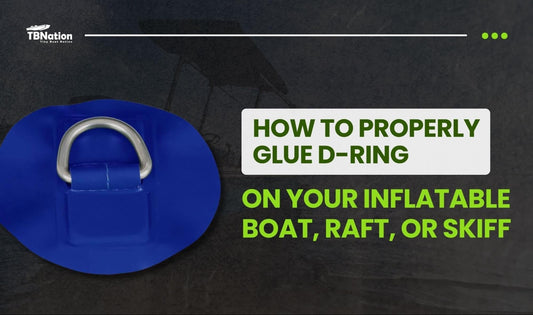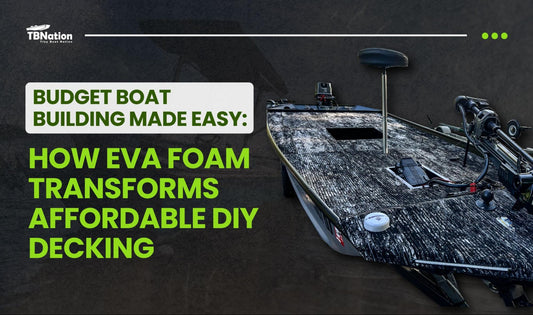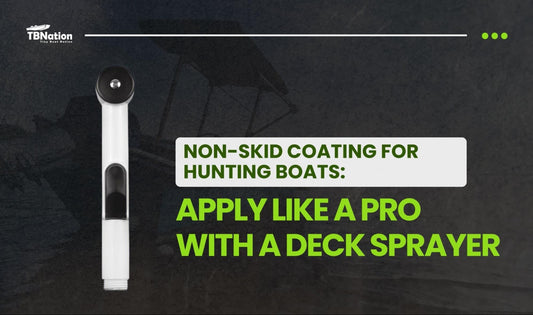Your Cart is Empty

How a Simple Plastic Lid Can Transform Your Jon Boat Deck
Key Takeaways
-
Plastic lids are a lightweight, water-resistant, and affordable alternative to traditional marine materials, making them ideal for upgrades on plastic jon boats and other small boats.
-
They provide exceptional versatility and can be used as access hatches, deck panels, storage covers, or enclosures for batteries and wiring.
-
Easy to customize, cut, and shape, allowing for tailored solutions that fit unique boat build designs.
-
Reduces overall costs while maintaining durability, helping boat builders work within budget without sacrificing quality.
-
Best practices include choosing UV-resistant lids, reinforcing load-bearing areas, sealing with rubber gaskets, and avoiding over-tightening screws to prevent damage.
-
This resourceful approach reflects a spirit of innovation and customization embraced by many in the small boat community, promoting creative problem-solving with readily available materials.
Upgrading a jon boat typically involves materials such as marine plywood, aluminum framing, or specialized hatches. However, many innovative builders have discovered the surprising utility of a far more accessible material: the plastic lid. Commonly found on storage bins and containers, these lids may not seem like obvious boat-building components, yet they offer a lightweight, waterproof, and affordable solution for a variety of applications.
From simple access hatches to complete deck panels, incorporating this material can transform your plastic or aluminum jon boat project, providing both practical advantages and creative flexibility. Its ease of use and cost-effectiveness make it an excellent alternative for enhancing your boat without the usual expense or complexity.
Why Consider Plastic Lids for Your Boat Build?
Lightweight and Water-Resistant
These components are naturally lightweight, which is crucial for jon boats where maintaining proper weight distribution helps ensure stability and optimal performance. They are typically made from water-resistant materials such as polypropylene or polyethylene. These materials do not rot, warp, or degrade when exposed to wet conditions. This durability makes them ideal for use in marine environments. Their light weight also contributes to improved fuel efficiency and handling.
Affordable and Readily Available
Compared to specialized marine hatch kits, these items are far more affordable. Many builders repurpose containers or purchase parts inexpensively from retail stores. This accessibility makes them an excellent choice for boaters working with a limited budget. The cost savings allow more investment in other critical areas of the boat. Their widespread availability means replacements or upgrades are easy to source.
Highly Versatile
These parts serve a wide range of functions in small boat builds. They can be used as storage compartment covers, providing quick access to gear while keeping contents dry and secure. They also work well as flush-mounted deck hatches, maintaining a smooth and walkable deck surface. Some builders use them as removable access panels for convenient inspection and maintenance.
Others convert them into battery or wiring enclosures, helping organize and protect electrical systems. When reinforced properly, they even function as lightweight decking components, adding to the boat’s overall structure and design flexibility.
How to Build a Functional Hatch Using a Plastic Lid
Choose the Right Cover
Start by selecting a durable and structurally sound option. Look for pieces made from high-quality plastic, preferably from heavy-duty storage bins, that feature ribbed reinforcements for added strength. Avoid thin or flexible versions, as they may not hold up well to regular use or exposure to the marine environment. A strong cover ensures long-term reliability and prevents warping, especially if it will be stepped on.
Cut the Deck Opening
Identify where the hatch will be located on your boat deck and mark the dimensions of your chosen cover. Use a jigsaw or oscillating multi-tool to cut an opening slightly smaller than the actual size, allowing for a tight, secure fit. Make sure the edges are smooth and level to ensure proper sealing. Take time to measure carefully, as an accurate cut is essential for both appearance and water resistance.
Add Structural Support
Once the opening is cut, build a support frame beneath it using treated wood, composite board, or aluminum angle. This structural reinforcement helps distribute weight evenly and prevents flexing or collapse when walked on. Secure the frame tightly to the underside of the deck for maximum stability. It also provides a solid surface for mounting and sealing around the perimeter.
Install and Seal
Position the cover over the opening and attach it to the support frame using stainless steel screws or marine-grade adhesive. Apply a bead of marine sealant around the edges to create a watertight barrier that prevents leaks. For improved sealing, especially in wet conditions, consider installing a rubber gasket or weatherstrip between the hatch and frame. Let the adhesive and sealant cure fully before using.
Optional Hardware
To improve usability, you can install hinges and a latch system, especially if the hatch will be accessed frequently. Use corrosion-resistant hardware such as stainless steel to ensure longevity in marine conditions. A small handle or recessed grip can make opening and closing easier. These additions not only enhance functionality but also give the finished hatch a clean, professional look.
How to Build a Fully Custom Deck Using Repurposed Materials
-
Plan the Deck Layout-Begin by designing the overall layout of your deck, identifying areas where access covers or removable panels will be installed. Use cardboard or foam board templates to visualize spacing and ensure a proper fit before making any cuts to your materials.
-
Construct the Frame -Build a sturdy subframe using pressure-treated wood, aluminum tubing, or PVC, depending on your budget and weight considerations. Secure this framework to your jon boat or aluminum hull with marine-grade adhesive, stainless steel screws, or rivets to ensure long-term durability.
-
Cut and Fit Panels -Trim each cover or panel to fit its designated section according to your layout. Sand the edges to prevent cracking and ensure a snug, flush fit within the supporting structure.
-
Mount and Seal -Secure each panel using corrosion-resistant fasteners or strong adhesive, depending on your construction method. Apply marine-grade caulk along all seams and edges to maintain water resistance and protect the substructure.
-
Finish the Surface-Complete your deck with a non-slip finish such as EVA foam, marine carpet, or textured marine paint. This final layer enhances traction, improves appearance, and ensures a safe, professional-grade surface.
Advantages of Using Repurposed Materials in a Small Boat Build
Cost Efficiency
Marine-grade components and accessories can often be expensive, quickly driving up the cost of a boat build. By repurposing affordable materials, builders can significantly reduce expenses without sacrificing essential functionality or durability.
This approach makes upgrading a jon boat accessible to budget-conscious enthusiasts. It allows for quality results while keeping overall spending in check. The savings can then be allocated to other important parts of the project.
Ease of Customization
One major advantage is how easily these materials can be modified to suit specific needs. They can be cut, drilled, and shaped with basic tools, allowing builders to create custom-fit components. This flexibility makes them ideal for applications such as livewell covers, battery compartments, or storage access panels. Customization ensures a perfect fit and seamless integration with the rest of the boat. It also encourages creativity and practical problem-solving during the build.
Replaceable and Modular
The modular nature of these components is highly beneficial for small boat projects. If one section becomes damaged, it can be removed and replaced independently without disturbing the overall structure. This makes maintenance simpler and more cost-effective over time. Modular parts also allow for easier upgrades or adjustments down the line. Such versatility enhances the boat’s longevity and usability.
Lightweight and Durable
Their lightweight quality contributes to better fuel efficiency and reduces strain on small motors, which is critical in compact jon boats. Despite being light, these materials offer impressive durability, resisting impacts, cracking, and weather damage.
This combination of strength and lightness improves both performance and handling on the water. Builders benefit from a sturdy, yet manageable solution that doesn’t add unnecessary weight. Overall, this enhances the boat’s reliability and ease of use.
Best Practices for Integrating Plastic Lids

-
Choose UV-Resistant Plastic to Prevent Degradation-When selecting materials for your boat build, opt for UV-resistant options to prevent cracking, fading, and brittleness caused by prolonged sun exposure. This will extend the lifespan and maintain the appearance over time. Using UV-stabilized plastic is especially important for components installed on exposed deck surfaces.
-
Reinforce Any Load-Bearing Areas with Proper Framing -Always reinforce areas that will bear weight by installing a sturdy subframe made from treated wood, aluminum, or composite materials. Proper framing prevents flexing, sagging, or cracking under pressure. This support ensures the surface remains structurally sound and safe to walk on.
-
Use Rubber Gaskets for Watertight Seals -To keep compartments dry, install rubber gaskets or weather stripping between the cover and the frame. This creates a tight, waterproof seal that prevents water intrusion, even in rough conditions. Well-sealed openings protect valuable equipment and storage areas from moisture damage.
-
Avoid Over-Tightening Screws, Which Can Cause Cracking -When fastening, be careful not to over-tighten screws or bolts, as excessive pressure can cause cracking or deformation. Use stainless steel washers to distribute pressure evenly and reduce stress on the material. Tighten hardware just enough to secure the part firmly without causing damage.
-
Test Each Compartment for Water Resistance Before Use-Before finalizing your build, thoroughly test each hatch or cover for water resistance by spraying or lightly submerging it. Identify and fix any leaks or gaps to ensure full protection from water intrusion. This step helps guarantee your boat’s storage and electrical compartments remain dry and functional.
Why This Approach Aligns with Tiny Boat Nation Values
This approach embodies the values of ingenuity, affordability, and customization that many small boat builders embrace, including those in Tiny Boat Nation. By repurposing everyday items like a plastic lid, builders can create highly functional and efficient watercraft without relying on costly or specialized components. This mindset encourages creative problem-solving and resourcefulness, allowing boat enthusiasts to tailor their projects to meet specific needs while staying within budget.
Using unconventional materials challenges traditional ideas about boat construction by demonstrating that durable and effective results can come from unexpected sources. This method inspires both novice and experienced builders to think outside the box and prioritize smart, practical solutions. Embracing this philosophy fosters innovation and helps the small boating community grow stronger through shared creativity and accessible design techniques.
Conclusion: Innovation Through Simplicity
In the world of small boat modifications, the most effective solutions often come from the simplest materials. When used thoughtfully, a plastic lid can become an essential component of your next jon boat upgrade. Whether you’re creating a single access hatch or designing a full deck system, this unconventional material offers remarkable flexibility, significant cost savings, and surprising durability.
As you plan your next boat build, consider looking around your garage or workshop for items that can be repurposed. Sometimes, the perfect component is right at your fingertips, like the lid of a storage bin. This practical approach not only saves money but also encourages creativity and resourcefulness in every project.
Frequently Asked Questions
1: Why use a plastic lid in a jon boat build?
It offers a lightweight, waterproof, and cost-effective solution for various applications in a jon boat. It can serve as access hatches, storage covers, or even deck panels, providing durability without adding excessive weight.
2: Are plastic lids durable enough for small boat decks?
Yes. When properly reinforced with structural framing, high-quality lids from heavy-duty storage bins are strong enough to support weight and withstand exposure to water and sunlight, especially if UV-resistant versions are selected.
3: Can these lids be customized for different boat components?
Absolutely. They are easy to cut, drill, and shape, allowing boat builders to customize them for livewell covers, battery compartments, removable access panels, and other parts tailored to their specific needs.
4: How do they compare cost-wise to traditional marine hatches?
They are significantly more affordable than specialized marine-grade hatches. Many builders repurpose lids from household storage bins or buy them cheaply, making this an excellent option for budget-conscious DIY boat builders.
5: What are the best practices when installing these lids on a jon boat?
Key best practices include selecting UV-resistant options, reinforcing load-bearing areas with a sturdy frame, using rubber gaskets for watertight seals, avoiding over-tightening screws to prevent cracking, and testing compartments for water resistance before use.
6: Is this method popular within the Tiny Boat Nation community?
While this approach embodies the resourcefulness and creativity common among small boat builders, including communities like Tiny Boat Nation, it is widely appreciated by DIY enthusiasts who value affordability and customization in their small boat projects.
Join Our VIP List
Join the Tiny Boat Nation VIP Members List.
It's Free! Stay Up To Date With Announcements, Product Give Aways, News and Promotions.










